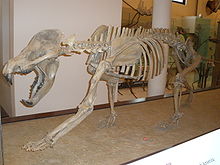| Amphicyonids | |
|---|---|

| |
| Skeleton of Amphicyon | |
| Scientific classification | |
| Domain: | Eukaryota |
| Kingdom: | Animalia |
| Phylum: | Chordata |
| Class: | Mammalia |
| Order: | Carnivora |
| Suborder: | Caniformia |
| Superfamily: | †Amphicyonoidea |
| Family: | †Amphicyonidae Haeckel, 1866 |
| Subfamilies | |
|
†Amphicyoninae | |
Amphicyonidae is an extinct family of terrestrial carnivorans belonging to the suborder Caniformia. They first appeared in North America in the middle Eocene (around 45 mya), spread to Europe by the late Eocene (35 mya), and further spread to Asia and Africa by the early Miocene (23 mya). They had largely disappeared worldwide by the late Miocene (5 mya), with the latest recorded species at the end of the Miocene in Africa. They were among the first carnivorans to evolve large body size. Amphicyonids are colloquially referred to as "bear-dogs".[1]
- ^ Wang, Xiaoming and Richard H. Tedford (2008). Dogs; their Fossil Relatives and Evolutionary History. Columbia University Press. pp. 10–11. ISBN 9780231135283.